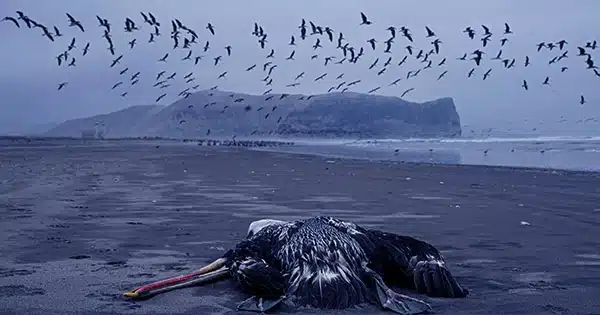The mating locations on Helgoland’s Lummenfelsen are gradually filling up again. The first gannet couples have returned to bill, some are already nesting, and others are just coming.
Actually, everything is normal at the beginning of April, just before the pelagic avian mating season – but something is different: According to Elmar Ballstaedt, the association’s protected area administrator for Helgoland Jordsand, there are considerably fewer gannets to be seen at their customary breeding locations, particularly on the plateaus and on the Lange Anna rock. It is unknown how many mating couples will visit Germany’s only offshore island until mid-April. However, there will be fewer than normal, according to Ballstaedt.
This has a somewhat historical explanation: For many years, avian movement in this country only coincided with bird flu outbreaks during the winter. The extremely contagious pathogen, however, persisted in 2022 and caused significant deaths in the seabird populations along the North Sea shore. According to Florian Packmor, who oversees mating birds at the Lower Saxony Wadden Sea National Park Administration, an epidemic in the midst of the breeding season like last year was totally novel.
Scientists and environmentalists are worried about the upcoming mating season on Heligoland and in the Wadden Sea National Parks, though, as the virus has been consistently found along the shore this year. They absolutely want to protect the colonies from devastating outbreaks like last year.
Colonies offer virus-optimal conditions: While hundreds of gannets died or had their breeding halted early in Helgoland in 2022, the virus in Lower Saxony mainly impacted sandwich terns, which were already on the verge of extinction. The virus was found in four of five sandwich tern populations near the German North Sea coast: Minsener Oog, Langeoog, Neuwerk, and the Hallig Norderoog. According to Packmor, nearly 3,000 deceased adult animals and 2,800 dead babies were discovered on Minsener Oog alone.
The sandwich tern breeding populations provided the virus with ideal circumstances for growth. The expert claims that sandwich tern mating communities are the Wadden Sea’s most congested. There are only 30 to 40 centimeters between eggs in the middle of the colonies. The white-feathered birds with the characteristic black crest actually defend themselves from predators by raising their offspring in crowded, noisy communities.
It was sad, in the eyes of the experts, that so many adult birds in particular perished. Sandwich terns, like gannets and guillemots, rely on growing old to guarantee their ongoing existence. “The survival of the adult birds is important to keep the population stable at all,” says Packmor.
A virus appears to alter the hue of gannets’ eyes: The gannet breeding rate in Heligoland was below normal last year. A different eye color has been noticed in some gannets there since the epidemic in the summer. Some birds, both those that have perished from the virus and those that are still living, have all or portion black irises.
“It looks like contact lenses on Halloween,” Ballstaedt explains. Such discoloration had never happened prior to the outbreak of avian flu, so it is safe to infer that these animals have recovered. However, little is known about migratory avian immunity.
In the forthcoming breeding season, scientists and environmentalists want to alter that and completely halt any potential new outbreaks. The Wadden Sea Secretariat of the States, which includes Denmark, Germany, and the Netherlands, organized a meeting in Wilhelmshaven at the end of March with virologists, ornithologists, epidemiologists, and veterinarians from Germany, the Netherlands, Denmark, Great Britain, and Sweden to discuss risk factors and the entry routes of the virus into the colonies.
Lower Saxony has begun a “series of pilot measures.”: The multidisciplinary session enabled different specialists to conduct a trilateral risk evaluation for avian flu in the Wadden Sea for the first time, according to Kristine Meise, program manager for migration and wildlife at the Wadden Sea Secretariat. “At the workshop, we agreed that there is a high risk of a new outbreak occurring.” However, it is impossible to forecast whether this will occur and which bird species will be impacted.
In order to be prepared for future breakouts, the specialists discussed potential courses of action. The Lower Saxony national park management intends to depend on a package of steps to safeguard the stock of sandwich terns: “We will now tackle a series of pilot measures,” said Packmor.
Monitoring needs to be increased the most. Sandwich tern chicks will be checked for the virus for the first time in order to gain an early understanding of the virus’s dissemination.
Webcams are designed to monitor colonies: Increased carcass gathering could be another solution. As a consequence, Meise claims that there is even a possibility of containing an outbreak. However, since collecting them also involves upsetting the colonies, such actions would need to be cautiously examined. Infected animals may move and disseminate the virus to new populations as a result. ” As a result, there are also considerations for installing outdoor webcams in the colonies, with which the sandwich terns, for example, could be remotely monitored.”
Ballstaedt and his coworkers on Helgoland scour the island for dead birds once a week and collect samples as needed. “For the time being, things are looking up for our seabirds.” “As of yet, none of the species have shown signs of bird flu,” adds Ballstaedt.
However, if the gannets become infected, guillemots, kittiwakes, and other species that nest on the Lummenfels will almost certainly be impacted as well. When bird flu broke out last year, the guillemot babies had already departed their nesting locations.















